 Elon Musk believes that direct brain interfaces will help people better transmit ideas to one another in addition to just allowing thought-to-text generation. But there is a fundamental problem with this idea. Let’s take Hubert Dreyfus’ conception of the way meaning works as being tied to a more holistic view of our social interactions with others. Hilary Putnam would probably agree with this perspective, though now I am speaking for two dead philosphers of mind. We can certainly conclude that my mental states when thinking about the statement “snow is white” are, borrowing from Putnam who borrows from Quine, different from a German person thinking “Schnee ist weiß.” The orthography, grammar, and pronunciation are different to begin with. Then there is what seems to transpire when I think about that statement: mild visualizations of white snow-laden rocks above a small stream for instance, or, just now, Joni Mitchell’s “As snow gathers like bolts of lace/Waltzing on a ballroom girl.” The centrality or some kind of logical ground that merely asserts that such a statement is a propositional truth that is shared in some kind of mind interlingua doesn’t bear much fruit to the complexities of what such a statement entails.
Elon Musk believes that direct brain interfaces will help people better transmit ideas to one another in addition to just allowing thought-to-text generation. But there is a fundamental problem with this idea. Let’s take Hubert Dreyfus’ conception of the way meaning works as being tied to a more holistic view of our social interactions with others. Hilary Putnam would probably agree with this perspective, though now I am speaking for two dead philosphers of mind. We can certainly conclude that my mental states when thinking about the statement “snow is white” are, borrowing from Putnam who borrows from Quine, different from a German person thinking “Schnee ist weiß.” The orthography, grammar, and pronunciation are different to begin with. Then there is what seems to transpire when I think about that statement: mild visualizations of white snow-laden rocks above a small stream for instance, or, just now, Joni Mitchell’s “As snow gathers like bolts of lace/Waltzing on a ballroom girl.” The centrality or some kind of logical ground that merely asserts that such a statement is a propositional truth that is shared in some kind of mind interlingua doesn’t bear much fruit to the complexities of what such a statement entails.
Religious and political terminology is notoriously elastic. Indeed, for the former, it hardly even seems coherent to talk about the concept of supernatural things or events. If they are detectable by any other sense than some kind of unverifiable gnosis, then they are at least natural in that they are manifesting in the observable world. So supernatural imposes a barrier that seems to preclude any kind of discussion using ordinary language. The only thing left is a collection of metaphysical assumptions that, in lacking any sort of reference, must merely conform to the patterns of synonymy, metonymy, and other language games that we ordinarily reserve for discernible events and things.… Read the rest







